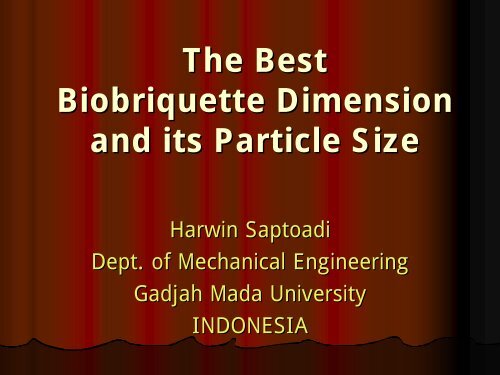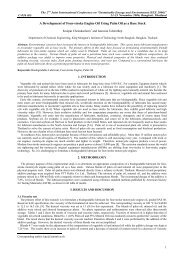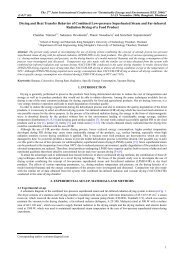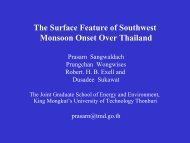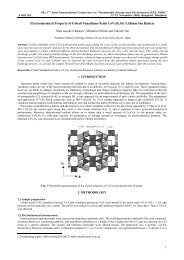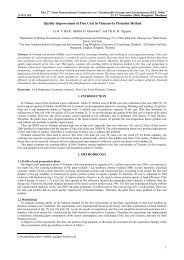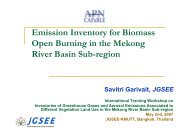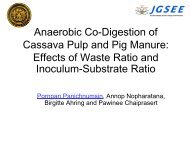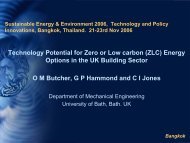The Best Biobriquette Dimension and its Particle Size
The Best Biobriquette Dimension and its Particle Size
The Best Biobriquette Dimension and its Particle Size
Create successful ePaper yourself
Turn your PDF publications into a flip-book with our unique Google optimized e-Paper software.
<strong>The</strong> <strong>Best</strong><br />
<strong>Biobriquette</strong> <strong>Dimension</strong><br />
<strong>and</strong> <strong>its</strong> <strong>Particle</strong> <strong>Size</strong><br />
Harwin Saptoadi<br />
Dept. of Mechanical Engineering<br />
Gadjah Mada University<br />
INDONESIA
INTRODUCTION :<br />
• Indonesia has abundant supply of biomass. Some<br />
portions become waste after <strong>its</strong> utilization, e.g. rice<br />
husk, rice straw, coconut fiber, coconut shell, palm<br />
oil shell, palm oil fiber, bagasse, , wood chip, saw<br />
dust, etc.<br />
• <strong>The</strong>se wastes can be used later on, either as natural<br />
fertilizer, or as h<strong>and</strong>icrafts or building materials, or<br />
as clean <strong>and</strong> renewable fuels.<br />
• It is briquetted to improve the energy density, to<br />
increase the heat capacity (the capability to retain<br />
heat for a longer period <strong>and</strong> maintain higher<br />
temperatures to facilitate easy ignition of fresh fuel<br />
charges), to reduce the amount of flying ash<br />
(because more ash is bound within <strong>its</strong> char), <strong>and</strong> to<br />
make h<strong>and</strong>ling, storage & transportation easier.
INTRODUCTION :<br />
• Coal or char is added into biomass briquettes to<br />
improve <strong>its</strong> heating value <strong>and</strong> combustibility. In<br />
terms of energy output <strong>and</strong> pollutant emissions, the<br />
optimum blending ratio of biomass with coal is<br />
between 10% <strong>and</strong> 30%. But the mixing ratio of 1 :<br />
3 for coal <strong>and</strong> biomass is used in this research.<br />
• It can be used for heat generation in households<br />
<strong>and</strong> small industries, or for power generation in<br />
large industries.<br />
• Different types of furnace are required according to<br />
heat release rates, briquette dimensions, heating<br />
values, etc. It is expected that the maximum<br />
reaction rate is maintained during combustion.<br />
Reaction rates are resulted from complex interaction<br />
of many variables.
METHODOLOGY :<br />
Two experiments have been carried<br />
out to investigate the influences of<br />
briquette dimension (Experiment 1)<br />
<strong>and</strong> composing particle size<br />
(Experiment 2) on the combustion<br />
characteristics.
MATERIALS :<br />
For the first experiment : wooden saw dust, lignite<br />
<strong>and</strong> natural binder. Briquettes are cylindrical with a<br />
diameter of 13 mm, made from 75% wooden saw<br />
dust <strong>and</strong> 25% lignite. <strong>The</strong>y are mixed with 40%<br />
natural binder (made from 16.6% cassava starch<br />
<strong>and</strong> 83.3% water). <strong>The</strong>re are three different<br />
briquette masses, i.e. 3 g, 4g <strong>and</strong> 5 g, respectively.<br />
For the second experiment : rice husk <strong>and</strong> natural<br />
binder (consist of 9.1% cassava starch <strong>and</strong> 90.9%<br />
water). Five different particle sizes are prepared, i.e.<br />
more than 100 mesh, 70 - 80 mesh, 60 - 70 mesh,<br />
50 - 60 mesh, <strong>and</strong> 40 - 50 mesh. <strong>The</strong> ratio between<br />
rice husk <strong>and</strong> binder is 3 : 1, <strong>and</strong> all the wet<br />
briquettes weigh initially 4 grams in the form of 16<br />
mm diameter cylinders.
EQUIPMENT :
LEGENDS :<br />
1. Combustion furnace.<br />
2. Digital scale to measure continuously the fuel mass.<br />
3. Digital <strong>The</strong>rmometer.<br />
4. <strong>The</strong>rmocouple to monitor the temperatures of air, hot<br />
gas <strong>and</strong> furnace wall.<br />
5. Heating torch to heat the combustion air (first<br />
experiment) or the furnace wall (second experiment).<br />
6. Fuel briquette.<br />
For the 1st experiment : briquettes are placed onto a<br />
11.7 cm diameter perforated plate which is located<br />
within the vertical combustion furnace where<br />
combustion air flows upward. A blower is provided to<br />
supply combustion air with various velocities.
PROCEDURES :<br />
• For the 1st experiment : to obtain the same initial<br />
weight of the fuels, the followings are selected : 20<br />
pcs of 3 g briquette, 15 pcs of 4 g briquette, <strong>and</strong> 12<br />
pcs of 5 g briquette. Air is supplied with 3 different<br />
rates (0.3 m/s, , 0.4 m/s, , <strong>and</strong> 0.5 m/s), with constant<br />
temperature of 70 C with the help of a LPG air heater.<br />
• For the 2nd experiment : <strong>The</strong> fuel is reacted one at a<br />
time. <strong>The</strong> furnace wall temperature is held constant,<br />
about 283 C. <strong>The</strong> flue gas temperature at a position<br />
behind the burning fuel is considered constant at<br />
roughly 135 C. <strong>The</strong> air at room temperature flows<br />
naturally.<br />
• <strong>The</strong> instantaneous masses for both experiments are<br />
recorded for every 15 seconds. <strong>The</strong> measurements are<br />
terminated if there is no mass decrease anymore.
RESULTS AND DISCUSSIONS :<br />
For the first experiment<br />
<strong>The</strong> results of combustion calculations are displayed<br />
in the following figures. Since the real process is<br />
highly fluctuated <strong>and</strong> make analyses very difficult,<br />
the oscillating curves are mathematically smoothed.<br />
By comparing those figures, particularly their<br />
smoothed curves, it can be concluded that smaller<br />
biobriquettes demonstrate better combustion<br />
characteristics (especially combustion rate) due to<br />
larger specific surface area available for reaction.<br />
More accessible surface area will obviously<br />
facilitate more O2O<br />
to bind carbon in a certain time<br />
period. <strong>The</strong>refore the smaller the specific surface<br />
area, the longer it will take to burn the briquettes.
C o m b u s tio n Rate s fo r 3 g Briq u e tte s<br />
240<br />
combustion rate<br />
(mg/s)<br />
200<br />
160<br />
120<br />
80<br />
40<br />
0<br />
v=0,5m/s<br />
v=0,4m/s<br />
v=0,3m/s<br />
Po ly . (v = 0 ,3 m /s )<br />
Po ly . (v = 0 ,4 m /s )<br />
Po ly . (v = 0 ,5 m /s )<br />
0 2 4 6 8 10 12 14 16 18 20 22 24 26 28<br />
tim e (m in u te s )<br />
Combustion Rates for 4 g Briquettes<br />
240<br />
combustion rate (mg/s)<br />
200<br />
160<br />
120<br />
80<br />
40<br />
0<br />
0 2 4 6 8 10 12 14 16 18 20 22 24 26 28<br />
time (minutes)<br />
v=0,5m/s<br />
v=0,4m/s<br />
v=0,3m/s<br />
Poly. (v=0,5m/s)<br />
Poly. (v=0,4m/s)<br />
Poly. (v=0,3m/s)<br />
C o m b u s tio n Rate s fo r 5 g Briq u e tte s<br />
v= 0,5m /s<br />
combustion rate<br />
(mg/s)<br />
240<br />
200<br />
160<br />
120<br />
80<br />
40<br />
0<br />
v= 0,4m /s<br />
v= 0,3m /s<br />
P oly. (v= 0,5m /s)<br />
P oly. (v= 0,4m /s)<br />
P oly. (v= 0,3m /s)<br />
0 2 4 6 8 10 12 14 16 18 20 22 24 26 28<br />
tim e (m in u te s )
RESULTS AND DISCUSSIONS :<br />
for the second experiment<br />
<strong>Particle</strong> size (microns) 150 180 -212 212 - 250 250 - 300 300 - 425<br />
Briquette mass (gram) 2.926 2.629 2.691 2.539 2.798<br />
Briquette height (mm) 15.95 18.00 18.30 20.75 23.90<br />
Briquette diameter (mm) 15.75 16.00 16.60 17.10 17.40<br />
Briquette volume (mm 3 ) 3108.8 3620.6 3962.2 4767.3 5685.4<br />
Briquette density (kg/m 3 ) 941.2 726.1 679.2 532.6 492.1<br />
Strain (%) 32.92 38.46 40.77 48.21 70.71<br />
Reacted mass (gram) 1.963 2.148 2.159 2.137 2.332<br />
Unburned mass (%) 32.91 18.30 19.77 15.83 16.65<br />
Combustion time (min) 28.0 25.5 24.0 22.0 19.25
RESULTS AND DISCUSSIONS :<br />
for the second experiment
RESULTS AND DISCUSSIONS :<br />
for the second experiment<br />
<strong>Particle</strong> sizes determine porosities. <strong>The</strong> smaller the<br />
particle size, the higher the density, <strong>and</strong> the lesser the<br />
porosity. <strong>The</strong> lowest density is 492.1 kg/m3, while the<br />
highest is 941.2 kg/m3.<br />
Briquettes of coarser rice husks exp<strong>and</strong> more after<br />
released from the molding. <strong>The</strong> strain shows that the<br />
finest particles will elongate 32.9% while the largest<br />
particles can reach 70.7%.<br />
Lower porosities hinder mass transfer, due to fewer free<br />
spaces for diffusion (H2O, VM, <strong>and</strong> CO2 outflows <strong>and</strong><br />
O2 infiltration), so <strong>its</strong> combustion rates will be lower.<br />
Briquettes from the largest particle burn in 19.25 min<br />
leaving 16% of unburned solid, while those from the<br />
smallest particle react until 28 min but leaving 33%<br />
unburned.
RESULTS AND DISCUSSIONS :<br />
<strong>The</strong> most appropriate furnace for the discussed<br />
biobriquettes is either suspension burning (crushed<br />
fuel) or fluidized bed, particularly CFB (circulating<br />
fluidized bed). However fluidized bed type can be<br />
better, since there is no need to provide pulverizing<br />
system because coarser briquettes are still acceptable.<br />
<strong>The</strong> resulted lower temperature within the fluidized<br />
bed combustion chamber is suitable for low ash<br />
melting characteristics typical for biomass.<br />
A research has been conducted using a BFB (bubbling<br />
fluidized bed) which burns pellets of Empty Fruit<br />
Bunch. <strong>The</strong> biomass waste is produced from palm oil<br />
mills.
CONCLUSIONS :<br />
It can be concluded from those two experiments<br />
that briquette dimensions should be as small<br />
as possible but their composing particles<br />
should be as coarse as possible. Combining<br />
those requirements, each briquette should be<br />
an impervious single very small unit. <strong>The</strong> most<br />
appropriate furnace type is fluidized bed,<br />
either circulating or bubbling types.
ACKNOWLEDGEMENT :<br />
<strong>The</strong> paper combines results of an international<br />
collaborative research project coordinated by Prof.<br />
Naruse from the Toyohashi University of Technology<br />
with another independent research carried out in the<br />
Gadjah Mada University. <strong>The</strong> author wishes to<br />
acknowledge gratefully <strong>The</strong> New Energy <strong>and</strong><br />
Industrial Technology Development Organization<br />
(NEDO-Japan) for the three year financial support,<br />
<strong>and</strong> also to thank his former students Ibnu Rois al<br />
Hakim <strong>and</strong> Taufan Enggar for their excellent<br />
Research Assistances.
THANK YOU<br />
VERY MUCH<br />
FOR YOUR<br />
ATTENTION


